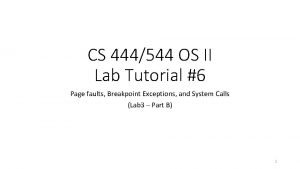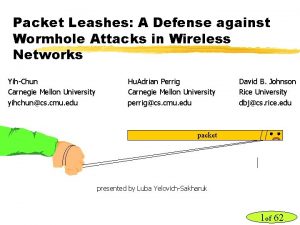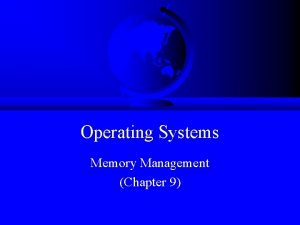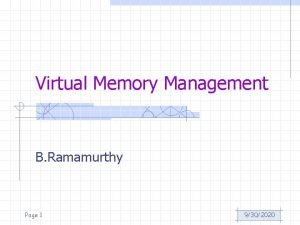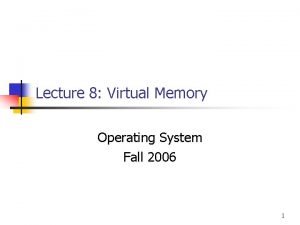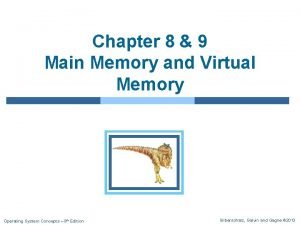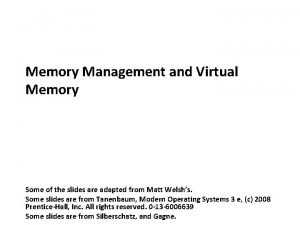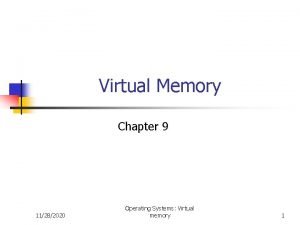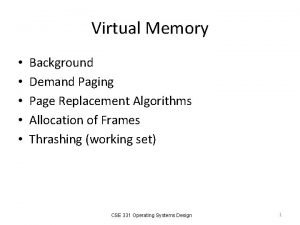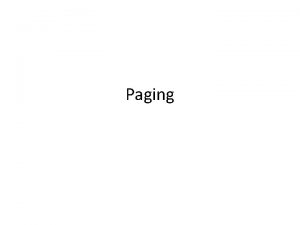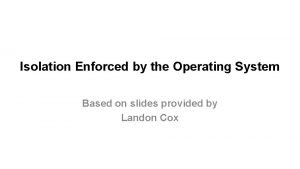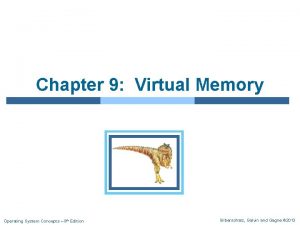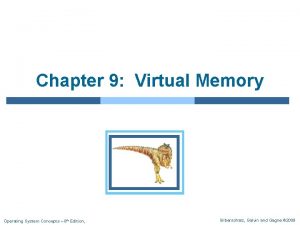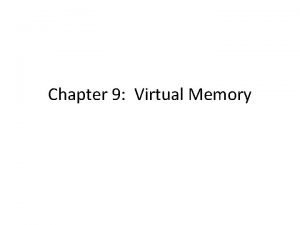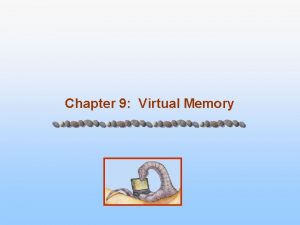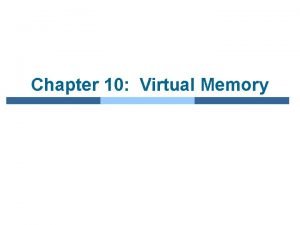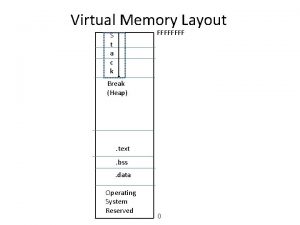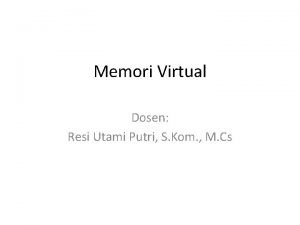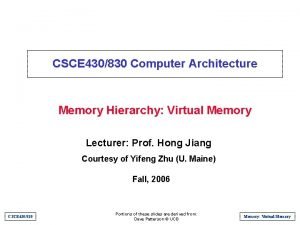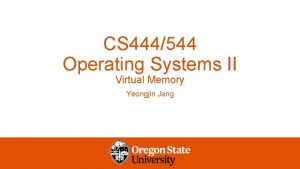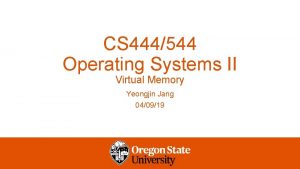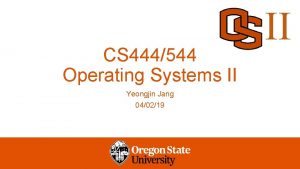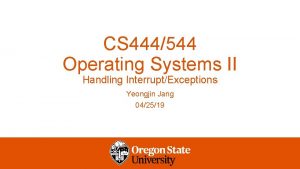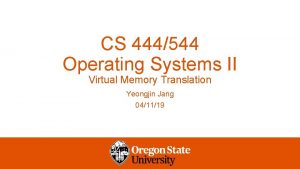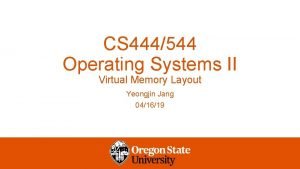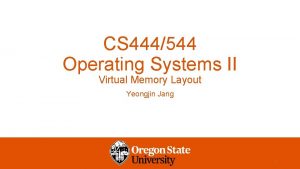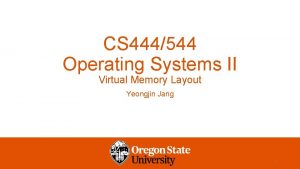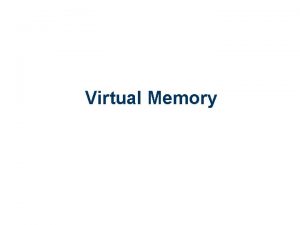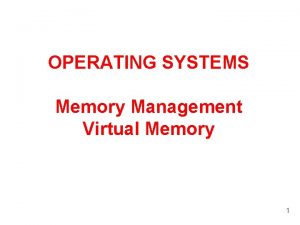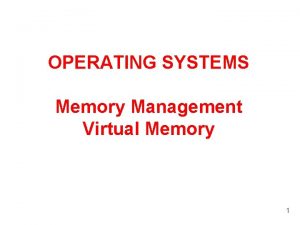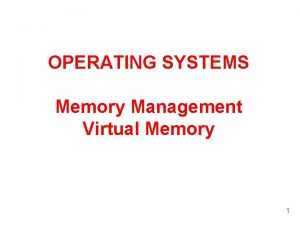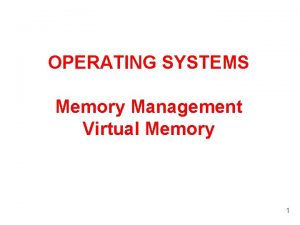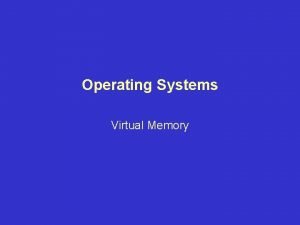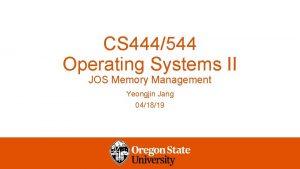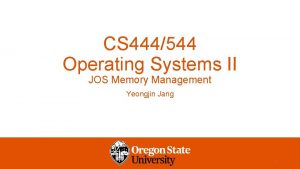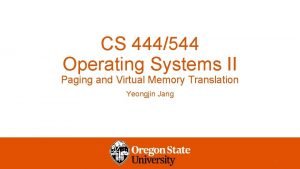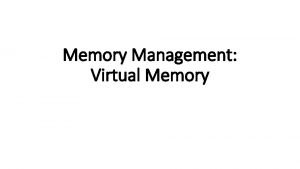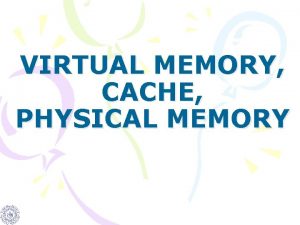CS 444544 Operating Systems II Virtual Memory Yeongjin







































- Slides: 39

CS 444/544 Operating Systems II Virtual Memory Yeongjin Jang 04/07/19

Recap – Real Mode • Real mode segmentation, how? • seg * 16 + offset • [b 000: b 7 ff] => 0 xb 000 * 16 + 0 xb 7 ff = 0 xbb 7 ff • What is A 20? • [f 800: 8001] => 0 x 100001? • [f 800: 8001] => 0 x 1? • FYI, segment registers are: • • • %cs – code segment %ds – data segment %es – extra segment %fs %gs %ss – stack segment Image from: https: //upload. wikimedia. org/wikipedia/commons/thumb/d/db/Overlapping_realmode_segments. svg

CPU / Registers / Memory CPU 200 ~ 300 clk Registers, 1 clk eax esp cs ebx ebp ds ecx edx eax Cache L 1 (3 clk) L 2 (7 clk) L 3 (30 clk) es eip fs esi gs edi ss General-purpose registers eip M M U Hidden register. You cannot access it cs Segment registers, stores CPL/RPL

Recap - JOS Boot Sequence • 0 xf 000: 0 xfff 0 – BIOS • Loads boot sector – runs 0 x 7 c 00 • Enable A 20 • Enable protected mode (enabling 4 GB memory access) • Read kernel ELF (Executable Linkable Format) • …

Need for Protected Mode: No Memory Privilege in Real Mode • Suppose two program runs at the same time • Program A attempts to modify memory used by program B Main Memory Program A • No SECURITY! Program B

i 386 Protected Mode • Look at GDT (Global Descriptor Table) • Indexed by a segment register • (selector) Images from: https: //sipb. mit. edu/iap/6. 828/files/x 86_translation_and_registers. pdf

i 386 Protected Mode • Base • Any 32 -bit address • Limit • 20 -bit, but could be multiplied by 4096 bytes • E. g. , 1 means 4096, 2 means 8192, etc. Images from: https: //sipb. mit. edu/iap/6. 828/files/x 86_translation_and_registers. pdf https: //wiki. osdev. org/Global_Descriptor_Table

i 386 Protected Mode • Look at GDT (Global Descriptor Table) • Indexed by a segment register • (selector) • Retrieve base address • Address = base + offset • Can access if (offset < limit) or • Can access if (offset < limit * 4096) • Depending on the values in flags! Images from: https: //sipb. mit. edu/iap/6. 828/files/x 86_translation_and_registers. pdf

i 386 Protected Mode • G - Granularity (0 = byte, 1 = page) • 0: Limit will be byte granularity (i. e. , limit, only access 220, 1 MB) • 1: Limit will be page granularity (i. e. , limit * 4096, 220 * 216 = 232) • D – Default operand size (0 = 16 -bit, 1 = 32 -bit) • Set the values of IP/SP with respect to this bit • R, X – Readable/Executable • DPL – Descriptor Privilege Level (a. k. a. Ring Level) • 0 (highest priv), 1, 2, 3 (lowest priv) For more information: https: //en. wikipedia. org/wiki/Protected_mode

Protected Mode - Examples • 0 x 0: 0 x 8080 • Base: 0 x 0 • Limit (addr): 0 xfffff 000 • Offset: 0 x 8080 • Offset < Limit (0 x 8080 < 0 xfffff 000)! • Address: 0 x 8080 GDT index 32 -bit Base 20 -bit Limit 12 -bit Flags 16 0 x 31310000 0 x 1 G=1 8 0 x 40000000 0 x 80000 G=1 0 0 xfffff G=1

Protected Mode - Examples • 0 x 8: 0 x 8080 • Base: 0 x 40000000 • Limit (addr): 0 x 8000000 • Offset: 0 x 8080 • 0 x 8080 < 0 x 8000000 • Address: 0 x 40008080 GDT index 32 -bit Base 20 -bit Limit 12 -bit Flags 16 0 x 31310000 0 x 1 G=1 8 0 x 40000000 0 x 80000 G=1 0 0 xfffff G=1

Protected Mode - Examples • 0 x 10: 0 x 333 • Base: 0 x 31310000 • Limit (addr): 0 x 1000 • Offset: 0 x 333 • Address: 0 x 31310333 • 0 x 10: 0 x 8080 • • • Base: 0 x 31310000 Limit (addr): 0 x 1000 Offset: 0 x 8080 Offset > limit Access denied! GDT index 32 -bit Base 20 -bit Limit 12 -bit Flags 16 0 x 31310000 0 x 1000 G=0 8 0 x 40000000 0 x 80000 G=1 0 0 xfffff G=1

Protected Mode – Memory Privilege • DPL (Descriptor Privilege Level) • Protected mode – four levels of memory privilege • 0 (00) – highest, OS kernel Kernel: for privileged OS operations… • 1 (01) – OS kernel ----------------------- • 2 (10) – highest user-level privilege. User: for unprivileged applications… • 3 (11) – user-level privilege

Protected Mode – Memory Privilege • No memory privilege in real mode • Protected mode – four levels of memory privilege • 0 – highest, OS kernel • 1 – OS kernel ---------------------- • 2 – highest user-level privilege • 3 – user-level privilege • Typically, 0 is for kernel, 3 is for user… Image from: https: //en. wikipedia. org/wiki/File: Priv_rings. svg

Descriptor Privilege Level Defines Ring Level • CPL = Current Privilege Level • Defined in the last 2 bits of the %cs register • You can change %cs only via lcall/ljmp/trap/int GDT index 32 -bit Base 20 -bit Limit 12 -bit Flags 16 USER 0 x 31310000 0 x 1000 G=0, DPL=3 8 KERNEL 0 x 40000000 0 x 80000 G=1, DPL=0 0 KERNEL 0 x 0 0 xfffff G=1, DPL=0

Descriptor Privilege Level Defines Ring Level • CPL = Current Privilege Level • Defined in the last 2 bits of the %cs register • You can change %cs only via lcall/ljmp/trap/int • Examples • • %cs == 0 x 8 %cs == 0 x 13 %cs == 0 x 10 %cs == 0 xb == 1000 in binary, last 2 bits are ZERO -> KERNEL! == 10011 in binary, last 2 bits are 3 -> USER! == 10000 in binary, last 2 bits are 0 -> KERNEL! == 1011…. GDT index 32 -bit Base 20 -bit Limit 12 -bit Flags 16 USER 0 x 31310000 0 x 1000 G=0, DPL=3 8 KERNEL 0 x 40000000 0 x 80000 G=1, DPL=0 0 KERNEL 0 x 0 0 xfffff G=1, DPL=0

Descriptor Privilege Level Defines Ring Level • CPL = Current Privilege Level • Defined in the last 2 bits of the %cs register • You can change %cs only via lcall/ljmp/trap/int • mov %ax, %cs impossible! • Can only move down… • CPL==0, then ljmp 0 x 3: 0 x 1234 is OK to execute • CPL==3, then ljmp 0 x 0: 0 x 1234 is not allowed GDT index 32 -bit Base 20 -bit Limit 12 -bit Flags 16 USER 0 x 31310000 0 x 1000 G=0, DPL=3 8 KERNEL 0 x 40000000 0 x 80000 G=1, DPL=0 0 KERNEL 0 x 0 0 xfffff G=1, DPL=0

OK, Kernel (Ring 0) can execute code in (Ring 3) via ljmp 0 x 3: 0 x 1234 • Then, how can we go back to kernel? • We can switch from ring 0 to ring 3 via ljmp • ljmp 0 x 3: 0 x 1234 • We cannot switch from ring 3 to ring 0 via ljmp • ljmp 0 x 0: 0 x 1234 illegal instruction • We use iret / sysexit / sysret to switch from ring 3 to ring 0 • We will learn this in week 4

Enabling Protected Mode (part 1): Create Global Descriptor Table (GDT) • In boot/boot. S • %cs to point 0 ~ 0 xffff in DPL 0 • %ds to point 0 ~ 0 xffff in DPL 0 • Only kernel can access those two segment GDT index 32 -bit Base 20 -bit Limit 12 -bit Flags 16 0 x 0 0 xfffff G=1, W DPL=0 8 0 x 0 0 xfffff G=1, XR DPL=0 0 0

Enabling Protected Mode (part 2): Change CR 0 (Control Register 0) Set PE (Protected enabled) to 1 will enable Protected Mode In JOS: 1. Load GDT 2. Read CR 0, store it to eax 3. Set PE_ON (1) on eax 4. Put eax back to CR 0 (PE_ON to CR 0!!)

How to Change CPL? • ljmp (instruction) • Long jump 0 x 8 == 1000, Last 2 bits are zero. .

Protected Mode Summary • Segment access via GDT • Base + Offset < Limit * 4096 (if G == 1) • Base + Offset < Limit (if G == 0) • Last two bits in %cs - CPL • Memory Privilege - Ring level • 0 for OS kernel • 3 for user application • Changing CR 0 to enable protected mode • CR 0_PE_ON == 1, set via eax • Changing CPL? • ljmp %cs: xxxxx, set the last 2 bits of %cs as 0 for kernel, 3 for user

Virtual Memory • Three goals • Transparency • Efficiency • Protection

Uniprogramming Environment • Run one program Stack - 1 Program Data - 1 • The program can use memory space freely… Program Code - 1 Free (576 KB) 0 x 10000 ~ 0 xa 0000 (64 KB ~ 640 KB) OS 0 x 00000 ~ 0 x 10000 (0 ~ 64 KB)

Uniprogramming Environment • Run one program • The program can use memory space freely… Stack (64 KB) Stack -1 0 x 80000 ~ 0 x 90000 (512 KB ~ 576 KB) Free (576 KB) 0 x 10000 Data ~ 0 xa 0000 Program (64 KB) (64 KB ~~640 KB) Program Data -1 0 x 40000 0 x 50000 (256 KB ~ 320 KB) Program Code - 1 OS 0 x 00000 ~ 0 x 10000 (0 ~ 64 KB)

Uniprogramming Environment • Run one program • The program can use memory space freely… Free (64 KB) 0 x 90000 ~ 0 xa 0000 (576 KB ~ 640 KB) Stack - 1 (64 KB) 0 x 80000 ~ 0 x 90000 (512 KB ~ 576 KB) Free (192 KB) 0 x 50000 ~ 0 x 80000 (320 KB ~ 512 KB) Program Data - 1 (64 KB) 0 x 40000 ~ 0 x 50000 (256 KB ~ 320 KB) Free (64 KB) 0 x 30000 ~ 0 x 40000 (192 KB ~ 256 KB) Program Code - 1 (128 KB) 0 x 10000 ~ 0 x 30000 (64 KB ~ 192 KB) OS 0 x 00000 ~ 0 x 10000 (0 ~ 64 KB)

Multi-programming Environment • Run two programs Stack - 2 (64 KB) Program Data - 2 (64 KB) Program Code - 2 (128 KB) Free (64 KB) 0 x 90000 ~ 0 xa 0000 (576 KB ~ 640 KB) Stack - 1 (64 KB) 0 x 80000 ~ 0 x 90000 (512 KB ~ 576 KB) Free (192 KB) 0 x 50000 ~ 0 x 80000 (320 KB ~ 512 KB) Program Data - 1 (64 KB) 0 x 40000 ~ 0 x 50000 (256 KB ~ 320 KB) Free (64 KB) 0 x 30000 ~ 0 x 40000 (192 KB ~ 256 KB) Program Code - 1 (128 KB) 0 x 10000 ~ 0 x 30000 (64 KB ~ 192 KB) OS 0 x 00000 ~ 0 x 10000 (0 ~ 64 KB)

Multi-programming Environment • Run two programs • System’s memory usage determines allocation • Program need to be aware of the environment • Where does system loads my code? • You can’t determine… system does. . No Transparency… Free (64 KB) 0 x 90000 ~ 0 xa 0000 Stack - 2 (64 KB) (576 KB ~ 640 KB) Stack - 1 (64 KB) 0 x 80000 ~ 0 x 90000 (512 KB ~ 576 KB) Free (192 KB) 0 x 50000 ~ 0 x 80000 Program Code - 2 (128 KB) (320 KB ~ 512 KB) Program Data - 1 (64 KB) 0 x 40000 ~ 0 x 50000 (256 KB ~ 320 KB) Free (64 KB) Program Data - 2 (64 KB) 0 x 30000 ~ 0 x 40000 (192 KB ~ 256 KB) Program Code - 1 (128 KB) 0 x 10000 ~ 0 x 30000 (64 KB ~ 192 KB) OS 0 x 00000 ~ 0 x 10000 (0 ~ 64 KB)

Multi-programming Environment • Run two programs Stack - 2 (64 KB) Program Data - 2 (64 KB) Program Code - 2 (160 KB) Free (64 KB) 0 x 90000 ~ 0 xa 0000 (576 KB ~ 640 KB) Stack - 1 (64 KB) 0 x 80000 ~ 0 x 90000 (512 KB ~ 576 KB) Free (96 KB) 0 x 68000 ~ 0 x 80000 (416 KB ~ 512 KB) Program Data - 1 (64 KB) 0 x 58000 ~ 0 x 68000 (352 KB ~ 416 KB) Free (128 KB) 0 x 38000 ~ 0 x 58000 (224 KB ~ 352 KB) Program Code - 1 (160 KB) 0 x 10000 ~ 0 x 38000 (64 KB ~ 224 KB) OS 0 x 00000 ~ 0 x 10000 (0 ~ 64 KB)

Multi-programming Environment • Run two programs • Program size: 64 KB + 160 K = • Free mem • 64 + 96 + 128 = 288 KB • Cannot run Program – 2 • Can’t fit… Free (64 KB) 0 x 90000 ~ 0 xa 0000 Stack - 2 (64 KB) (576 KB ~ 640 KB) Stack - 1 (64 KB) 0 x 80000 ~ 0 x 90000 288 KB (512 KB ~ 576 KB) Free (96 KB) Program Data - 2 (64 KB) 0 x 68000 ~ 0 x 80000 (416 KB ~ 512 KB) Program Data - 1 (64 KB) 0 x 58000 ~ 0 x 68000 (352 KB ~ 416 KB) Free (128 KB) Program Code - 2 (160 KB) 0 x 38000 ~ 0 x 58000 (224 KB ~ 352 KB) Program Code - 1 (160 KB) 0 x 10000 ~ 0 x 38000 (64 KB ~ 224 KB) Not efficient. . Suffers memory fragmentation problem. . OS 0 x 00000 ~ 0 x 10000 (0 ~ 64 KB)

Multi-programming Environment • Run two programs • What if Program-2’s stack underflows? • What if Program-2’s data overflows? • Without virtual memory • Programs can affect to the other’s execution No isolation. Security problem. Free (64 KB) Stack - 2~ (64 KB) 0 x 90000 0 xa 0000 (576 KB ~ 640 KB) Stack (64 KB) 0 x 80000 ~ 0 x 90000 (512 KB ~ 576 KB) Free (192 KB) Program Code - 2 (128 KB) 0 x 50000 ~ 0 x 80000 (320 KB ~ 512 KB) Program Data (64 KB) 0 x 40000 ~ 0 x 50000 (256 KB ~ 320 KB) Free (64 KB) Program Data - 2 (64 KB) 0 x 30000 ~ 0 x 40000 (192 KB ~ 256 KB) Program Code (128 KB) 0 x 10000 ~ 0 x 30000 (64 KB ~ 192 KB) OS 0 x 00000 ~ 0 x 10000 (0 ~ 64 KB)

Virtual Memory • Three goals • Transparency: does not need to know system’s internal state • Program A is loaded at 0 x 8048000. Can Program B be loaded at 0 x 8048000? • Efficiency: do not waste memory; manage memory fragmentation • Can Program B (288 KB) be loaded if 288 KB of memory is free, regardless of its allocation? • Protection: isolate program’s execution environment • Can we prevent an overflow from Program A from overwriting Program B’s data?

Paging • A method of implementing virtual memory • Split memory into multiple 4, 096 byte blocks (12 -bit) • Last 3 digits of page address are ZERO (in hexadecimal) • E. g. , 0 x 0, 0 x 1000, 0 x 2000, …, 0 x 8048000, 0 x 804 a 000, …, 0 x 7 fffe 000, etc. • Having an indirect map between virtual page and physical page • • Set an arbitrary virtual address for a page, e. g. , 0 x 81815000 Set a physical address to that page as a map, e. g. , 0 x 32000 0 x 81815000 ~ 0 x 81815 fff will be translated into 0 x 32000 ~ 0 x 32 fff

Virtual Memory - Paging Physical Memory • Having an indirect table that maps virt-addr to phys-addr Stack 0 xbffdf 000 Virtual Physical 0 x 8048000 0 x 10000 Program code 0 x 804 a 000 0 x 8049000 0 x 11000 Program code 0 x 8049000 0 x 804 a 000 0 x 14000 0 xbffdf 000 0 x 12000 … … Program code 0 x 8048000 Program code 0 x 14000 Stack 0 x 12000 Program code 0 x 11000 Program code 0 x 10000

Paging: Virtual Memory • Having an indirect table that maps virt-addr to phys-addr Stack-2 0 xbffdf 000 Stack 0 xbffdf 000 Program code-2 0 x 804 a 000 Program code-2 0 x 8049000 Program code-2 0 x 8048000 Program code 0 x 8048000 Virtual Physical 0 x 8048000 0 x 10000 0 x 8049000 0 x 11000 0 x 804 a 000 0 x 14000 0 xbffdf 000 0 x 12000 … … Virtual-2 Physical-2 0 x 8048000 0 x 13000 0 x 8049000 0 x 15000 0 x 804 a 000 0 x 16000 0 xbffdf 000 0 x 17000 … … Physical Memory Stack-2 0 x 17000 Program code-2 0 x 16000 Program code-2 0 x 15000 Program code 0 x 14000 Program code-2 0 x 13000 Stack 0 x 12000 Program code 0 x 11000 Program code 0 x 10000

Transparency: does not need to know system’s internal state Program A is loaded at 0 x 8048000. Paging: Virtual Memory Can Program B be loaded at 0 x 8048000? • Having an indirect table that maps virt-addr to phys-addr Stack-2 0 xbffdf 000 Stack 0 xbffdf 000 Program code-2 0 x 804 a 000 Program code-2 0 x 8049000 Program code-2 0 x 8048000 Program code 0 x 8048000 Virtual Physical 0 x 8048000 0 x 10000 0 x 8049000 0 x 11000 0 x 804 a 000 0 x 14000 0 xbffdf 000 0 x 12000 … … Virtual-2 Physical-2 0 x 8048000 0 x 13000 0 x 8049000 0 x 15000 0 x 804 a 000 0 x 16000 0 xbffdf 000 0 x 17000 … … Physical Memory Stack-2 0 x 17000 Program code-2 0 x 16000 Program code-2 0 x 15000 Program code 0 x 14000 Program code-2 0 x 13000 Stack 0 x 12000 Program code 0 x 11000 Program code 0 x 10000

Efficiency: do not waste memory Can Program B (288 KB) be loaded if Paging: Virtual Memory only 288 KB of memory is free, regardless of its allocation? • Having an indirect table that maps virt-addr to phys-addr Stack-2 0 xbffdf 000 Stack 0 xbffdf 000 Program code-2 0 x 804 a 000 Program code-2 0 x 8049000 Program code-2 0 x 8048000 Program code 0 x 8048000 Virtual Physical 0 x 8048000 0 x 10000 0 x 8049000 0 x 11000 0 x 804 a 000 0 x 14000 0 xbffdf 000 0 x 12000 … … Virtual-2 Physical-2 0 x 8048000 0 x 13000 0 x 8049000 0 x 15000 0 x 804 a 000 0 x 16000 0 xbffdf 000 0 x 17000 … … Physical Memory Stack-2 0 x 17000 Program code-2 0 x 16000 Program code-2 0 x 15000 Program code 0 x 14000 Program code-2 0 x 13000 Stack 0 x 12000 Program code 0 x 11000 Program code 0 x 10000

Protection: isolate program’s execution environment Can we prevent an overflow from Program A from Paging: Virtual Memory overwriting Program B’s data? Stack-2 0 xbffdf 000 No mappings, FAULT! Stack 0 xbffdf 000 No mappings, FAULT! Program code-2 0 x 804 a 000 Program code-2 0 x 8049000 Program code-2 0 x 8048000 Program code 0 x 8048000

x 86 Memory Access
 444544
444544 Yeongjin jang
Yeongjin jang Yeongjin jang
Yeongjin jang Demand paging in virtual memory
Demand paging in virtual memory Demand paging in virtual memory
Demand paging in virtual memory Virtual memory and cache memory
Virtual memory and cache memory Virtual memory in memory hierarchy consists of
Virtual memory in memory hierarchy consists of Memory management operating system
Memory management operating system Semantic memory
Semantic memory Implicit memory vs explicit memory
Implicit memory vs explicit memory Long term memory vs short term memory
Long term memory vs short term memory Internal memory and external memory
Internal memory and external memory Primary memory and secondary memory
Primary memory and secondary memory Memory swaping
Memory swaping Which memory is the actual working memory?
Which memory is the actual working memory? Eidetic memory vs iconic memory
Eidetic memory vs iconic memory Symmetric shared memory architecture
Symmetric shared memory architecture Demand paging in virtual memory
Demand paging in virtual memory Aging algorithm
Aging algorithm Advantage
Advantage Explain virtual memory in computer architecture
Explain virtual memory in computer architecture Demand paging in virtual memory
Demand paging in virtual memory Virtual memory in os
Virtual memory in os Process virtual address space
Process virtual address space Virtual memory os
Virtual memory os Virtual memory
Virtual memory Virtual memory segmentation
Virtual memory segmentation Memory hierarchy
Memory hierarchy Virtual memory os
Virtual memory os Virtual memory os
Virtual memory os Virtual memory is commonly implemented by
Virtual memory is commonly implemented by Virtual memory
Virtual memory Virtual memory os
Virtual memory os Shared pages
Shared pages Kai hierarchy
Kai hierarchy Tlb
Tlb Virtual memory layout
Virtual memory layout Apa karakteristik dari memori virtual?
Apa karakteristik dari memori virtual? Csce 430
Csce 430 Virtual memory
Virtual memory
